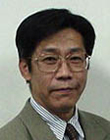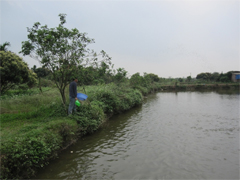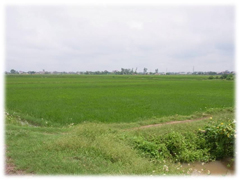Top>Research>Transformation of agriculture and peasant livelihoods in the rural Red River Delta in Vietnam under the influence of a developing market economy
 Index
Index

Norio Nishihata [Profile]
Education Course
Transformation of agriculture and peasant livelihoods in the rural Red River Delta in Vietnam under the influence of a developing market economy
Norio Nishihata
Specially Appointed Professor of Theory of International Development, Theory of International Cooperation, and Theory of Project Management, Faculty of Economics, Chuo University
1. Economic development based on biased resource allocation (disparity between agriculture and industry)
According to General Statistics Office (GSO) of Vietnam, the capital region of Hanoi and the Ho Chi Minh area account for 86% of national industrial output and 40% of the entire population. This indicates that about 60% of the entire population residing outside the Hanoi capital region and the Ho Chi Minh area make up the remaining 14% of national industrial output. It is obvious that industrial growth is made in a bipolarized style. Such biased economic growth is the outcome of the long-term governmental investment in the capital region and the Ho Chi Minh area. In order to develop economic and social infrastructure after the long conflict, the government invested scarce national resources in the capital region and the Ho Chi Minh area, which includes the southern industrial zone, on a priority basis. Capital was not procured by the government, but through foreign direct investment and ODA especially in 3 years from 1993, which accounts for nearly 40% of the total investment in the infrastructure in these regions. As a result, gross national product increased and industrialization progressed steadily, but investments were concentrated in urban and industrial sectors, and so the industrial structure got awkwardly bipolarized. According to the GSO statistics in 2007, economic growth rate was 3.7% for the field of agriculture, forestry, and fisheries, 10.2% for the mining and industrial field, 8.9% for the service field, and 8.5% on average. The productivity in the agricultural field is extremely low. The working population and employment rate in the field of agriculture, forestry, and fisheries, the industrial field, and the service field were 23.9 million (53%), 8.5 million (19%), and 12.7 million (28%), respectively. There is a 6-fold disparity between agriculture and industry in GDP per capita. The (relative) poverty rate in 1998 was 37.4% for the entire country, 9.0% for the urban area, and 44.9% for the rural area, and the value in 2007 was 15%, 7%, and 17%, respectively. Namely, poverty rate decreased by over 50%, except the urban area. The poverty line is 500,000 dong per month for the urban area (as of May 7, 2012), and 440,000 dong per month for the rural area. Meanwhile urban minimum wage is 1,100,000 dong, but it is hard to live in the urban area, and so migrant workers tend to return to their hometowns. Inflation rate is 32.1% (as of Nov. 2011: GSO), and has been over 20% over the past 5 years. This is a serious social issue, which is agonizing especially migrant farmers. It is not easy to go to the urban area to work.
2. Poverty and wealth in the rural area <farming families in Phu Dien and Huong Xa Villages>
Phu Dien Village, Nam Sack District, Hai Duong Province can be reached by heading east along national route 5 from Hanoi (heading for Ha Long or Hai Phong) for about 40 minutes, turning north, and driving for about 40 minutes. It takes about 60 km from Hanoi.
A total of 7 farming families were surveyed by visiting them for 2 days based on both the structured and unstructured survey methods. The outline is as follows: Firstly, the attributes of the 7 farming families were researched. The area of owned land was 7 sao (1 sao = 360 m2: equivalent to 0.25 ha), 8 sao (0.29 ha), 11 sao (0.4 ha), 12 sao (0.43 ha), and 28 sao (1 ha). Except for the 1 ha farming house, they have 0.3-0.4 ha. This village has made a living by cultivating rice, but this region was a lowland swamp with poor drainage, and so it was difficult to cultivate two rice crops a year. In 1998, ponds were dug for fish culture based on administrative support (this support was continued until 2001). In parallel, they started farming pigs and growing vegetables in their homesteads. Namely, they adopted the VAC model (the diversified model of livestock breeding, fish farming, and vegetable growing). Each farming family is considered to try to maximize their income by diversifying their work, including livestock breeding, fish farming, and vegetable growing in addition to rice cultivation by combining land resources. It is not clear whether land resources are combined for maximizing income. A 1-ha farming family allocated 90% of land resources to fish farming, and monthly equivalent disposable income per person was 22,000,000 dong. Since the poverty line in the rural area is 440,000 dong, they earn 50 times the poverty line, and so they are one of the wealthiest households in the village. Even the farming family with the lowest income among the 7 families earns 1,610,000 dong as monthly equivalent disposable income per person. I interviewed local people, and found that it costs at least 2,000,000 dong for 4 family members to lead a humble life (as of March 2012). This can be converted to 1,000,000 dong of monthly equivalent disposable income per person, and so it can be considered that the low-income family can lead an above-average life. The average monthly equivalent disposable income per person of the 7 families in the village is about 6,600,000 dong, and so it can be concluded that these families are wealthy. How do they engage in farming? They belong to many formal and informal organizations, exchange information frequently, and attend a lot of meetings. The network among farmers appeared to be quite close. Some farmers own motorbikes, use wholesalers to sell vegetables and fish, and deliver them to a provincial market. It is possible to travel up to 30 km by bicycle, but by motorbike, it is possible to travel farther to go to a distant market. But, they do not go to the Hanoi capital region. They are sensitive to the existence of a market, the information on the prices of agricultural products, and the access to agricultural and livestock breeding technologies. This reminds me of The Rational Peasant authored by Samuel Popkin. The farmers are aglow, have a positive attitude, and aim to maximize their income.

Aquaculture pond of a farming family that adopted the VAC model in Phu Dien Village
On the other hand, Huong Xa Village, Quat Dong, the old Ha Tay Province (present: Hanoi) is the rural area around Hanoi located 35 km or 1.5 hours by car northwest from Hanoi. In recent years, factories have been built in the vicinity through urbanization and industrialization. Hanoi is too far by bicycle, but commutable by motorbike. According to the survey targeted at 7 farming families, the area of owned land was 13.9 sao (0.5 ha), 6 sao (0.22 ha), 7.8 sao (0.28 ha), 2.6 sao (0.09 ha), 5 sao (0.18 ha), 3 sao (0.11 ha), and 2.6 sao (0.09 ha). This village is an intact agricultural suburb without any farming ponds or VAC agriculture. The monthly equivalent disposable income per person of agricultural income (2 rice crops) is 1,760,000 dong, 320,000 dong, 330,000 dong, 260,000 dong, 1,030,000 dong, and the other two families purchase 60,000 dong and 84,000 dong of rice per person every month. Namely, their agricultural incomes are in the red because they have to buy rice for home use. This is lower than the poverty line in the rural area, that is, they lead a rugged life. The residents in this village have produced traditional embroidery works as their sideline business, because they could not make a living by ultra-small agriculture. This village is characterized by embroidery craftsmanship, too. Embroidery brokers, who have connections for the routes of material procurement, production, and sale, entrust neighboring farmers with work. Such entrusted farmers receive the wage for production, to support their livelihoods. Some commute by motorbike to a small restaurant as a cook in Hanoi, some housewives work in a nearby textile factory, and others conduct small-scale livestock breeding. They are striving to increase their incomes. The calculated monthly equivalent disposable income per person is 4,200,000 dong, 320,000 dong, 4,270,000 dong, 1,380,000 dong, 3,870,000 dong, 13,580,000 dong, and 1,480,000 dong. This indicates significant disparity. Among the farming families I visited, the families earning over 4,000,000 dong have close personal networks, while serving as village chief, chairperson of a farmers' association, or a broker of embroidery works, etc. Other low-income farmers do not have close connections with high-income farmers. The average monthly equivalent disposable income per person in this village is 4,160,000 dong, which is only 60% of the average income in the above mentioned Phu Dien Village.

Paddy fields in Huong Xa Village, Quat Dong, the old Ha Tay Province (present: Hanoi)
After visiting the two agricultural villages, it was observed that the farmers in Phu Dien Village had jovial countenance, laughed often, and were energetic. In addition, the activities of each association in Phu Dien Village were livelier than in Huong Xa Village. The production of traditional embroidery works, which is the sideline business of low-income farmers in Huong Xa Village, did not increase their incomes so much due to the limitations of their technical level. However, farmers in the village donate rice, etc. to widows, elderly people, and low-income farmers to support their livelihoods. Namely, there are the customs of mutual assistance and labor exchange. I felt that the principle of equality and mutual benefit, which characterizes the Red River delta, still remains. In this village, residents do not have the willingness to create opportunities to increase their incomes together. Does an annual inflation rate of 20-30% lead the villagers to poverty sooner or later? They would share poverty, but there are limitations. How would they secure their livelihoods when reaching the limitations?
Some agricultural villages are wealthy, but impoverished farming families are increasing. This is the actual situation in the rural areas around Hanoi in early 2012. From a macroscopic viewpoint, the downturn in the purchasing power of agricultural villages would certainly dampen the industrial sector, and the current economic growth, which is supported by foreign direct investment, would be affected through the ignorance of the downturn of agricultural villages.
The coexistence of the modern economy-centered society and the mutually-supportive village, which shares poverty, would become a significant factor to change the social relations inside each village and between them.
(This field survey was conducted based on the scientific research grant for fiscal 2011. For the cooperation in the field survey, I would like to express my heartfelt thanks to many researchers, practitioners, and friends, including ISPONRE Prof. Nguyen The Chinh, NEU Prof. Nguyen Thi Than Thuy, Eco Eco Mr. Nguyen Sy Linh, Hanoi University of Agriculture, Vice Dean Prof. Nguyen Van Song, Prof. Nguyen Mau Dung, Sr. Lecturer Mr. Ho Ngoc Cuong, Sr. lecturer Ms. Do Thi Diep, and Mr. Phan Anh Duc.)
References
- Cho, Kenji [2005], Agriculture and farming villages in Vietnam under a market economy, Tsukuba Shobo
- Tran Van Tho [2010], Theory of Economic Growth in Vietnam-Traps for a middle-income country and the new Doi Moi, Keiso Shobo
- Geertz, Clifford [1963] Agricultural Involution, University of California Press.
- Little, Daniel [1988] Collective Action and the Traditional Village, Colgate University
Statistical materials
- General Statistics Office of Vietnam(GSO)(Latest access date: May 7, 2012)
- http://www.gso.gov.vn/default_en.aspx?tabid=491(Latest access date: May 7, 2012)
- The World Bank Stats Data : http://www.worldbank.org/(Latest access date: May 7, 2012)
- Norio Nishihata
Specially Appointed Professor of Theory of International Development, Theory of International Cooperation, and Theory of Project Management, Faculty of Economics, Chuo University - Born in Hyogo Prefecture, on April 23, 1947.
Earned a master's degree at a graduate school of University of Bradford in the UK in 1981. Resign from the doctoral course the Institute of Social Studies, Erasmus University, in the Netherlands in 1983. Worked in Japan International Cooperation Agency (JICA) for 32 years. Served as a visiting professor of Graduate School of Tokyo University of Foreign Studies. Appointed as a specially appointed professor of Faculty of Economics, Chuo University in April 2004. In charge of the classes of international development and exercise, etc. in Faculty of Economics, Faculty of Policy Studies, and Graduate School. Served as chairperson of the fourth long-term general plan council of Inagi City, a citizen's college lecturer of the board of education of Inagi City, Director of Japan Agency for Development and Emergency (JADE), a training advisor for foreign government officials of Japan International Cooperation Agency (JICA), and a member of the expert panel of Africa Workshop of Institute of Developing Economies of Japan External Trade Organization, etc. Experience of overseas work: Embassy of Japan in Nigeria and Foreign Ministry of Mongolia
- Research Activities as a Member of Research Fellowship for Young Scientists (DC1), Japan Society for the Promotion of Science (JSPS) Shuma Tsurumi
- Important Factors for Innovation in Payment Services Nobuhiko Sugiura
- Beyond the Concepts of Fellow Citizens and Foreigners— To Achieve SDGs Goal 10 “Reduce Inequality Within and Among Countries” Rika Lee
- Diary of Struggles in Cambodia Fumie Fukuoka
- How Can We Measure Learning Ability?
—Analysis of a Competency Self-Assessment Questionnaire— Yu Saito / Yoko Neha - The Making of the Movie Kirakira Megane








